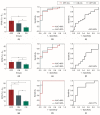Measuring Gait Quality in Parkinson's Disease through Real-Time Gait Phase Recognition
- PMID: 29558410
- PMCID: PMC5876748
- DOI: 10.3390/s18030919
Measuring Gait Quality in Parkinson's Disease through Real-Time Gait Phase Recognition
Abstract
Monitoring gait quality in daily activities through wearable sensors has the potential to improve medical assessment in Parkinson's Disease (PD). In this study, four gait partitioning methods, two based on thresholds and two based on a machine learning approach, considering the four-phase model, were compared. The methods were tested on 26 PD patients, both in OFF and ON levodopa conditions, and 11 healthy subjects, during walking tasks. All subjects were equipped with inertial sensors placed on feet. Force resistive sensors were used to assess reference time sequence of gait phases. Goodness Index (G) was evaluated to assess accuracy in gait phases estimation. A novel synthetic index called Gait Phase Quality Index (GPQI) was proposed for gait quality assessment. Results revealed optimum performance (G < 0.25) for three tested methods and good performance (0.25 < G < 0.70) for one threshold method. The GPQI resulted significantly higher in PD patients than in healthy subjects, showing a moderate correlation with clinical scales score. Furthermore, in patients with severe gait impairment, GPQI was found higher in OFF than in ON state. Our results unveil the possibility of monitoring gait quality in PD through real-time gait partitioning based on wearable sensors.
Keywords: Parkinson’s disease; gait phases recognition; gait quality; machine learning; motor fluctuations; wearable sensor system.
Conflict of interest statement
The authors declare no conflict of interest.
Figures


Similar articles
-
Gait initiation is impaired in subjects with Parkinson's disease in the OFF state: Evidence from the analysis of the anticipatory postural adjustments through wearable inertial sensors.Gait Posture. 2017 Jan;51:218-221. doi: 10.1016/j.gaitpost.2016.10.017. Epub 2016 Oct 31. Gait Posture. 2017. PMID: 27816900 Free PMC article.
-
A new instrumented method for the evaluation of gait initiation and step climbing based on inertial sensors: a pilot application in Parkinson's disease.J Neuroeng Rehabil. 2015 May 5;12:45. doi: 10.1186/s12984-015-0038-0. J Neuroeng Rehabil. 2015. PMID: 25940457 Free PMC article.
-
Impact of motor fluctuations on real-life gait in Parkinson's patients.Gait Posture. 2018 May;62:388-394. doi: 10.1016/j.gaitpost.2018.03.045. Epub 2018 Mar 28. Gait Posture. 2018. PMID: 29627498
-
Assessing Gait in Parkinson's Disease Using Wearable Motion Sensors: A Systematic Review.Diseases. 2019 Feb 5;7(1):18. doi: 10.3390/diseases7010018. Diseases. 2019. PMID: 30764502 Free PMC article. Review.
-
Quantified self and human movement: a review on the clinical impact of wearable sensing and feedback for gait analysis and intervention.Gait Posture. 2014;40(1):11-9. doi: 10.1016/j.gaitpost.2014.03.189. Epub 2014 Apr 6. Gait Posture. 2014. PMID: 24768525 Review.
Cited by
-
Inertial Sensor-Based Instrumented Cane for Real-Time Walking Cane Kinematics Estimation.Sensors (Basel). 2020 Aug 19;20(17):4675. doi: 10.3390/s20174675. Sensors (Basel). 2020. PMID: 32825029 Free PMC article.
-
Foot Pressure Wearable Sensors for Freezing of Gait Detection in Parkinson's Disease.Sensors (Basel). 2020 Dec 28;21(1):128. doi: 10.3390/s21010128. Sensors (Basel). 2020. PMID: 33379174 Free PMC article.
-
An Analysis of Body Language of Patients Using Artificial Intelligence.Healthcare (Basel). 2022 Dec 10;10(12):2504. doi: 10.3390/healthcare10122504. Healthcare (Basel). 2022. PMID: 36554028 Free PMC article.
-
Sensitivity to gait improvement after levodopa intake in Parkinson's disease: A comparison study among synthetic kinematic indices.PLoS One. 2022 May 12;17(5):e0268392. doi: 10.1371/journal.pone.0268392. eCollection 2022. PLoS One. 2022. PMID: 35551300 Free PMC article.
-
A Validation Study of Freezing of Gait (FoG) Detection and Machine-Learning-Based FoG Prediction Using Estimated Gait Characteristics with a Wearable Accelerometer.Sensors (Basel). 2018 Sep 30;18(10):3287. doi: 10.3390/s18103287. Sensors (Basel). 2018. PMID: 30274340 Free PMC article.
References
-
- Hegde N., Bries M., Sazonov E. A Comparative Review of Footwear-Based Wearable Systems. Electronics. 2016;5:48. doi: 10.3390/electronics5030048. - DOI
-
- Mileti I., Taborri J., Rossi S., Petrarca M., Patane F., Cappa P. Evaluation of the effects on stride-to-stride variability and gait asymmetry in children with Cerebral Palsy wearing the WAKE-up ankle module; Proceedings of the 2016 IEEE International Symposium on Medical Measurements and Applications (MeMeA); Benevento, Italy. 15–18 May 2016; pp. 1–6. - DOI
MeSH terms
LinkOut - more resources
Full Text Sources
Other Literature Sources
Medical
Miscellaneous

